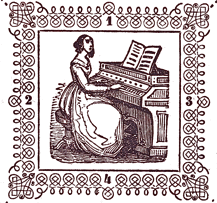| 

Detail from an advertisement for Debain's orgue-harmonium,
Revue et gazette musicale, vol. 10 no. 18, April 30, 1843, 453.
Carmel Raz
Dissertation Abstract:
REVERBERATING NERVES: PHYSIOLOGY, PERCEPTION, AND EARLY ROMANTIC AUDITORY CULTURES
Early Romanticism is haunted by ethereal sounds. Like an apparition or idée fixe, they appear in poetry and literature, in instrument design and orchestration, in medical texts and in spiritualist practices. This dissertation provides an account of these sonic experiences by investigating Romantic auditory cultures at the intersection of music and neural science. Bringing methodologies from the history of science, sound studies, and cognitive historicism to bear on music history and analysis, it examines early nineteenth-century conceptions of the neurophysiological effects of music and sound. My main claim is that Romantic music and medically-inflected listening practices drew heavily on specific understandings of perception and the nerves shared between musicians, medical scientists, philosophers, and nineteenth-century audiences. The contribution of this study lies in uncovering the influence of neural science on the formation of early Romantic music aesthetics, recovering an unexplored range of early nineteenth-century engagements with sound.
My first chapter, “The Harmonious Keyboard of the Mind,” sets up the background to the close interaction of early Romantic music and the neural sciences. I begin with a history of the analogy of nervous anatomy as musical instrument, a mechanist twist on the Platonic tradition that starts with Descartes. Next, I trace recurring philosophical metaphors that relied upon various properties of musical performance to illustrate memory, habit, and complex automatic behaviors. Focusing on representations of keyboardists within eighteenth and early nineteenth-century texts on the nature of cognition, I show how shifting accounts of the role of attention in musical performance reflect changes in philosophical configurations of the mind-body relationship. Moreover, I argue that details provided by successive writers about the instrument, agency, and identity of the performer reveal the influence of musical culture on the debate around volition.
Chapter two, “Ether, Ethereality, and the Aeolian Harp,” concentrates on the relationship between conceptions of both sound and nervous transmission as the movement of an ethereal substance akin to electricity, and the literary metaphor of the Aeolian harp, an instrument that resonates with the wind. Given that poetic discourse around the Aeolian harp draws on specific neurophysiological theories of resonance and association, I explore musical representations of the instrument in relationship to the staging of mental events in programmatic music, offering new interpretations of specific passages in works by Beethoven, Reicha, Knecht, and Berlioz.
In the third chapter, “‘The Expressive Organ Within Us:’ the Harmonium as a Case Study in Early Romantic Neurophysiology,” I examine medical case reports on the use of the harmonium in treating catalepsy. The harmonium, invented around 1808, represented an influential addition to the sonic world of the early Romantic era. Based on the deployment and depiction of the instrument within medical practice, I argue that the reception of the harmonium constitutes a continuation of the auditory culture which formed around the ethereal timbres and swelling sounds of a number of newly popular musical instruments, including the glass harmonica and the Aeolian harp, over half a century earlier. I link these insights to a number of depictions of the harmonium within the work of Honoré de Balzac, where the instrument is consistently allied with characters undergoing some form of mental instability.
My fourth chapter, “Hector Berlioz’s Neurophysiological Imagination,” locates Berlioz’s thought within the orbit of early nineteenth-century French physiology by investigating the composer’s documented reception of the works of the French physicians Xavier Bichat, Pierre-Jean Cabanis, and the biologist Jean-Baptiste Lamarck. Reading Berlioz’s self-reports of music’s effect on his own person through Bichat’s neurophysiological model, I offer new interpretations of his music criticism, as well as his compositional innovations in orchestration, form, and music spatialization. I further argue that we can understand the biological, physiological, and neurophysiological components of Berlioz’s theory of musical affect as addressing the embodied experience of aesthetically generated transcendence.
My final chapter, “Séances and Self-Playing Accordions: Musical Instruments in Victorian Spiritualism,” traces the origins of distinct auditory cultures around the so-called “spirit accordion,” an instrument that appeared to produce sound of its own volition in spiritualist séances. While ethereal sounding spirit accordions begin to appear around 1855, their reception was based in large part upon eighteenth-century understandings of ether, action at a distance, and the nature of nervous transmission. As I show in this chapter, these ideas —and their attendant sounds— continued to exert force within mystical and alternative contexts well into the twentieth century. Comparing séance soundscapes reported by spiritualist believers with those described by skeptics, I argue that this controversy can productively illuminate ways in which historical conceptions of cognition and neurophysiology result in distinctive modes of listening.
Back
|

![]()
